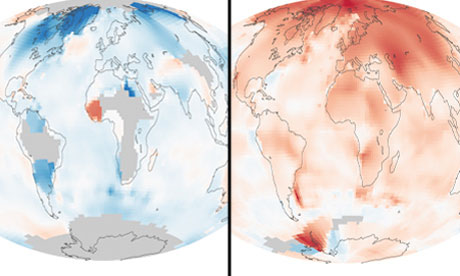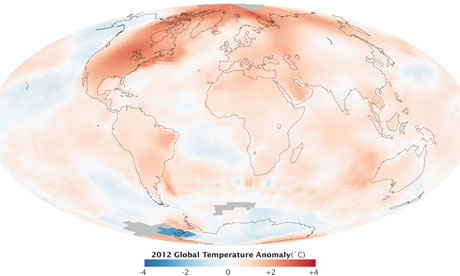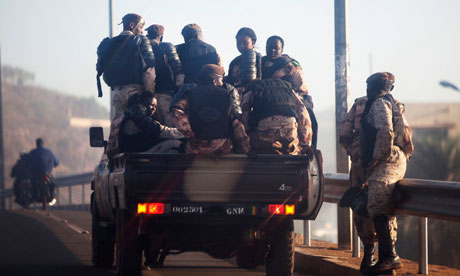Mali: a guide to the conflict
Malians have welcomed France's decision to commit forces but there are fears conflict could spread in fragile Sahel region
The issue at a glance
France last week launched air strikes against Islamist camps and mobile forces in
Mali, its former colony, to stop a rebel offensive and "safeguard" Mali's existence. President François Hollande said France intended to "destroy" the Islamists or take them captive if possible. Islamists have warned that French troops will become bogged down for years.
Brief history
After gaining independence in 1960, Mali endured decades of instability until Alpha Oumar Konaré was elected president in the country's first democratic election in 1992. He was succeeded in 2002 by Amadou Toumani Touré, a former army lieutenant-colonel who ruled until a coup launched last year by a group of young officers angry at the military's failure to stop Islamist insurgents.
Why is Mali politically significant?
The west and Mali's neighbours fear that the Islamists, who took over northern Mali, an area the size of France of desert and rugged mountains, will use the country to destabilise the rest of west
Africa, including neighbouring Niger, France's main source of uranium for its nuclear industry. Nigeria already faces a growing Islamist threat in Boko Haram; its president, Goodluck Jonathan, has said: "We can no longer surrender any part of the globe to extremism." Bamako, the capital, is also home to about 6,000 French citizens.
How did the rebels get so far?
Relations between the north and south have been historically fraught. The north has chafed under southern rule; the region has seen major rebellions from the Tuareg – nomadic – communities who feel marginalised in an already poor country. There have been rebellions in the 1990s, 2006-08 and the one last year that precipitated the present crisis. According to the International Crisis Group, a Brussels thinktank, deep resentment was caused by
stories of massacres, the poisoning of wells and forced exile from 1963, score-settling by pro-government militias against Tuareg civilians in the 1990s. The 2012 rebellion was partly an unintended consequence of Muammar Gaddafi's downfall in Libya. The Libyan "blowback" took the form on an influx of Libyan weapons and the return of Tuaregs who formerly fought for the Libyan dictator. Those weapons and the presence of seasoned fighters tipped the balance. In early 2012, the rebels swept aside government troops in the north and started imposing sharia law. They banned smoking and music and made women wear headscarves. Timbuktu proved a key moment in the rebellion, as the hardline Islamist groups MUJWA and Ansar Dine, backed by AQIM, al-Qaida's north African wing, took the ascendancy over the more secular group, the National Movement for the Liberation of Azawad (MNLA). In a move reminiscent of the destruction of the Buddha statues in Bamiyan, Afghanistan,
Islamist militants damaged Sufi tombs inside a 15th-century mosque in Timbuktu. Ansar Dine displaced MNLA as the main rebel group, thanks to AQIM's financial support. It has managed to recruit some elements of the MNLA by paying them.
What was the effect of the rebel success on the south?
The initial rebel gains were the final straw for an already disgruntled military. Junior officers had long been unhappy with Touré as they were passed over for promotion in favour of officers from Touré's generation. The increasing number of western hostages captured in neighbouring countries and whisked to northern Mali, described as AQIM's sanctuary, further damaged Touré's reputation. At the end of 2010, AQIM had reportedly received €50m worth of ransom money since 2003, with each western hostage worth around €2.5m to the countries that paid up. In March 2012, a junta consisting of junior officers led by Captain Amadou Haya Sanogo attacked the presidential palace just weeks before scheduled elections. The mutineers said they acted because of the government's failure to provide adequate equipment to the army to defend the country's territorial integrity. A massacre of about 20 soldiers at Aguelhoc in particular incensed the officers. Before the coup, the rebels needed only two months to capture several positions, including Tessalit and Amachach. After the coup, an increasingly disorganised army abandoned three regional capitals, Kidal, Timbuktu and Gao.
What happens next?
Despite bombardments from French warplanes and helicopters, the insurgents pushed south towards the capital, Bamako, and
overran the central town of Diabaly, 250 miles to the north, where French troops are heading. The French defence minister, Jean-Yves Le Drian, described the Islamists as heavily armed, very determined and very well organised – a French helicopter was shot down on the first day of the strikes. France, which plans to deploy 2,500 soldiers, says the offensive against the rebels could take some time, and the current French level of involvement could last weeks.
France's move has won the unanimous backing of the UN security council and its force has been deployed under UN security council resolution 2085. Passed in December, it allows for a 3,000-strong African-led mission to intervene in Mali in the absence of any negotiated solution.
Paris wants troops from Ecowas, the west African regional grouping, to deploy as quickly as possible, rather than September – the original timetable for the 3,300-strong UN-sanctioned African force – to be backed by western logistics, money and intelligence services. However, Nigeria, which is due to lead the mission, has warned that even if some troops arrive in Mali soon, their training and equipping will take more time. One senior government adviser in Nigeria said the Mali deployment was stretching the country's military, which already has peacekeepers in Darfur, Sudan. "The whole thing's a mess," he told Reuters. "We don't have any troops with experience of those extreme conditions, even of how to keep all that sand from ruining your equipment. And we're facing battle-hardened guys who live in those dunes."
Key issues
For now, the rebels have fled Gao, Kidal and Timbuktu, but the concern is whether the government can exert lasting control and provide security as the Islamists,
experienced and highly motivated desert fighters, resort to hit-and-run tactics. Analysts say that Mali needs credible brokers rather than President Blaise Compaoré of Burkina Faso, who is distrusted by Malians. There is not much faith either in Romano Prodi, the former Italian prime minister and UN envoy of the Sahel crisis, who does not speak French and is not an expert in the region.
Algeria is a key player as it is in the position of putting the most pressure on armed groups based there and its intelligence services have longstanding relations with Ansar Dine's leader, Iyad Ag Ghali. It also has long history with AQIM, as many of the group's fighters are former Algerian rebels. A big fear among analysts such as the International Crisis Group is that Mali will be seen through a "war on terror" prism, sidelining the fundamental issue of how to reconcile north and south. The north feels the south never lived up to the "national pact" of the 1990s, with its plans of gradual demilitarisation of the north, integration of rebels into special units of the national forces and economic plans to narrow the gap between north and south.
Key players
François Hollande
The French president, whose decision has received broad political support for now, felt he had little choice but to intervene given the real possibility of the Islamists taking over all of Mali. So Hollande is following in the footsteps of his predecessors from Charles de Gaulle to Nicolas Sarkozy by intervening in a former French African colony. So far the public is backing him, but that can soon change if French troops suffer heavy casualties or if intervention drags out. Security has been increased at Parisian landmarks at the Eiffel Tower and outside the Louvre.
Dioncounda Traoré
The interim president is viewed with some suspicion by Malians as he was an ally of the unpopular deposed president Touré. Traoré has been unable to work effectively with the junta behind the coup to lay the groundwork for the deployment of African troops.
Al-Qaida in the Maghreb (AQIM)
AQIM is the successor to the Salafist Group for Preaching and Combat, which came out of the Armed Islamic Group of Algeria, itself a product of the Algerian civil war. It numbered only a few hundred until early 2012, but they are experienced fighters, some of whom received military training in Afghanistan. Their ranks have probably grown since the takeover of the north.
Ansar Dine
Ansar Dine is not fighting for independence but wants sharia across the whole country. Its leader, Iyad Ag Ghali – a Tuareg noble and longtime thorn in the side of Bamako – and his supporters follow the Wahhabi sect of Islam, and are opposed by those Tuaregs who describe themselves as secularists, while most Malian Muslims belong to the rival Sufi tradition.
MNLA
The MNLA was created in 2011 by Tuareg activists after their former leader, Ibrahim ag Bahanga, was killed in a "car accident". The MNLA is a coalition of various groups, and its military leader is Mohamed Ag Najim, a Malian Tuareg who served under Gaddafi as a senior officer until the regime collapsed. It seeks independence for the Tuaregs' northern homeland, which it calls Azawad.
Key facts
Mali is a vast landlocked country located in the heart of the Sahel, a region threatened by drought and desertification. The vast majority of the people rely on the environment for their livelihoods through herding, farming, or fishing.
Population: 15,839,538 (2011)
GDP: $10,589,925,352 (2011)
GDP growth: 2.6% (2011)
Inflation: 2.8% (2011)
Economic overview
According to government estimates and a recent household survey, the poverty headcount fell from 55.6% in 2001 to 47.5% in 2006 and 43.6% in 2010. Income poverty remains a largely rural phenomenon, with the rural population representing 78% of the total population. The incidence of rural poverty dropped from 65% in 2001 to 51% in 2010. Farmers, who make up 62% of the population, are the poorest, with a 57% poverty rate. Households headed by women tend to be less poor than those headed by men. Extreme poverty has dropped at the national level from 32% in 2001 to 22% in 2011, with clear regional variations.
According to the most recent data made available by the World Bank, 77.1% of Malians lived under the international poverty line in 2006 (earning less than $2 per day). It is among the world's poorest 25 countries. Despite the global financial crisis of 2008, Mali enjoyed two recent years with a growth rate of 4.7% and 5.1% (respectively 2009 and 2010).
In greater depth
An International Crisis Group report in July 2012,
Mali: Avoiding Escalation, provides invaluable background to the present crisis, rich in detail and insight.
In favour of intervention
Gregory Mann argues that French
intervention was necessary to stop the Islamists from taking the town of Sevaré, which would have meant the loss of the only airstrip in Mali capable of handling heavy cargo planes, apart from that in Bamako. But he warns that France faces a determined and sophisticated foe.
Against
In an article before the French intervened, Abdelkader Abderrahmane, senior researcher with the Institute for Security Studies in Addis Ababa, argued that
Ecowas troops would be unable to defeat the Islamists. He favours a dialogue with the MNLA and Ansar Dine to take into account the legitimate claims of the Tuaregs.
Caution
Bérangère Rouppert, a Sahel expert, highlights the risks that the intervention, although popular now, will take on a neocolonial tinge.

 Temperature anomalies, or changes, by region in 2012. Reds and blues show how much warmer or cooler each area was in 2012 compared to an averaged base period from 1951-1980. Photograph: GISS/NASA
Temperature anomalies, or changes, by region in 2012. Reds and blues show how much warmer or cooler each area was in 2012 compared to an averaged base period from 1951-1980. Photograph: GISS/NASA






